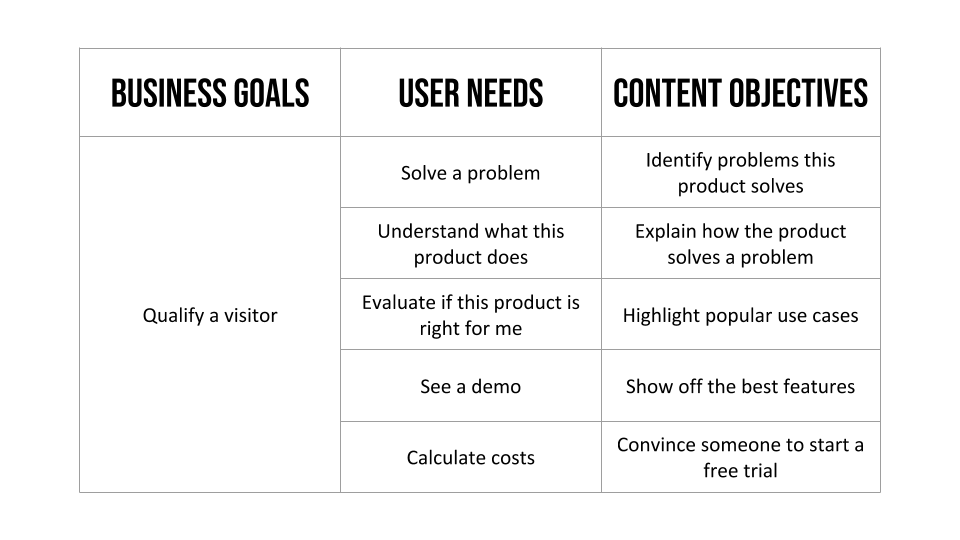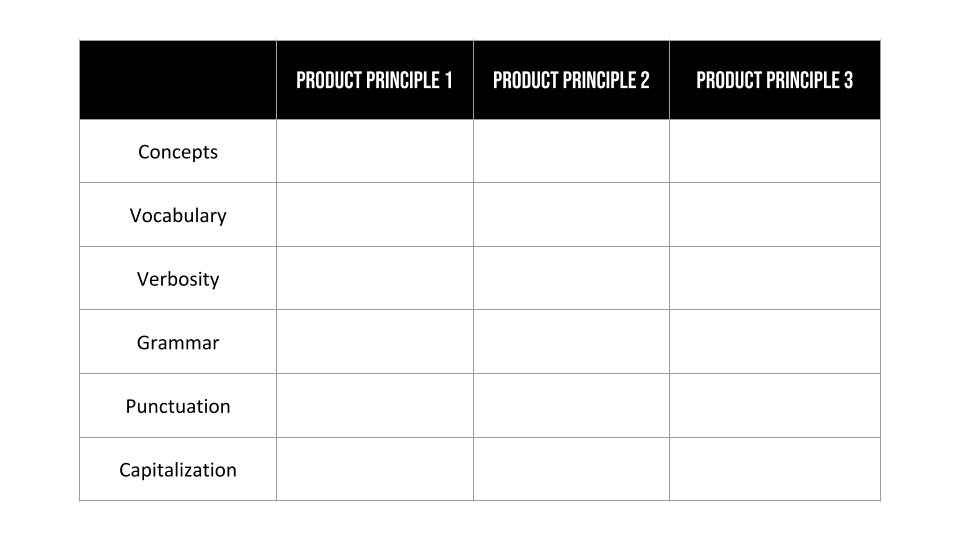Frameworks and Free Tools to Improve Your UX Writing
Bring a strategic approach to your next UX writing assignment
Welcome to the sixth edition of Full Stack Content. This week’s post is similar to a presentation that I shared with the Boulder UI/UX Meetup group a couple of weeks ago.
Join me at the Product-Led Summit (July 27–31, 2020) for an updated version of this talk focused on writing compelling copy for digital ads and landing pages. If you can’t afford the $99 ticket, then email contentstrategy@substack.com, and I’ll see what I can do.
Now, on to today’s post!
—
What Is UX Writing?
User experience (UX) writing is the design of the conversation between a product and its user.
You encounter UX writing all the time. UX writing is on websites, in apps, and whenever you call on/summon/use Siri, Alexa, or Cortana. Even instruction manuals and the buttons on your microwave are examples of UX writing.
Did You Say UX Writing Is Design?
Yes, well, sorta.
UX writing is the design of the conversation between a product and its user.
Everyone who has used a computer has encountered a dialogue box.
Dialogue boxes are one specific form of a user interface (UI). Other interfaces include menus, buttons, control panels, and voice commands.
UI is how people interface (or interact) with computers. The writing and design of these interfaces should ideally happen synchronously.
What Does a UX Writer Do?
A UX writer works alongside designers, developers, and product managers to create intuitive and efficient experiences. A UX writer is responsible for writing the text for the interface. A UX writer also participates in many non-writing activities, such as research, sketching, and strategy.
Above all, UX writers strive to create text that is clear, concise, and usable.
Kevin Pichinte provides an excellent example of how thoughtfully written text can improve the user experience.
Framework for Setting UX Writing Goals
Goals are foundational to every writing project. I use this simple framework all the time.
The first step is to clarify your business goal(s). Think critically through (or research!) what the user needs to accomplish to meet your business goal. Finally, identify how your content (UX writing) can support the user in their journey.
Here’s an example for a B2B SaaS (Software as a Service) website.
If you’re having trouble clarifying your goals, the next framework can help.
Framework for Choosing UX Metrics
Teams sometimes struggle with setting specific goals that drive business.
Combining these two methods can help you:
HEART Framework: Categories of metrics to measure the quality of user experience
Goals-Signals-Metrics: Process to prioritize the goals of your product or project
A team at Google pioneered the HEART framework and shared it in this research paper from 2010. I had the opportunity to work with Kerry Rodden, one of the original researchers, on this animated version of the HEART framework. Kerry also wrote an essay about choosing UX metrics for Google Venture in 2015.
UX metrics track progress toward goals. These metrics tend to fall within five categories.
Happiness: Attitudinal dimensions such as satisfaction, appeal, perceived ease of use
Engagement: Level of involvement with a product such as frequency
Adoption: Measures of popularity such as count of unique users
Retention: Measures of “stickiness” such as count of returning users
Task Success: Behavioral dimensions such as efficiency, effectiveness, and error rates
Depending on the scenario, you could be setting goals for an entire product or a specific feature. The HEART framework and Goals-Signals-Metrics-process can help you with either.
Goals: Important outcomes that you want for your users
Signals: Generalized indicators that your product is enabling that outcome
Metrics: Specific measurements that you’ll track over time to assess improvement
You can put those together into a simple table like this.

Frameworks for Defining Brand
“Brand” is a subliminal concept that is a combination of customer perception and emotional connection. Below are 10 “emotional motivators” that, according to a 2015 article in the Harvard Business Review, significantly affect customer value and drive consumer behavior.
Stand out from the crowd
Have confidence in the future
Enjoy a sense of well-being
Feel a sense of freedom
Feel a sense of thrill
Feel a sense of belonging
Protect the environment
Be the person I want to be
Feel secure
Succeed in life
Smart UX writers understand how to tap into these emotional motivators. They write UI copy that fosters a positive connection between users and products. Whether they realize it or not, UX writers are responsible for the brand.
The following four frameworks align teams and provide a reference point by which you should evaluate UX writing. I’ve listed these from most abstract to most specific. It’s helpful to codify decisions for each level.
Brand Archetypes
Archetypes are models of people, behaviors, or personalities that were introduced by Carl Jung. Jung suggested that these “inborn tendencies” play a role in influencing human behavior. Jungian archetypes represent universal patterns and images.

Although abstract, this framework can be useful when defining a new brand. Here are a few examples to help you connect the dots.
Jester: The joker is living their best life right now. Their goal is to get you to giggle by any means necessary. They’re comedians and pranksters.
Brand example: Slap ChopLover: The Lover is all about intimacy, relationships, passion, and compassion. They’re partners, friends, team-builders, support staff, and sensualists.
Brand example: Dove ChocolateMagician: The Magician is a charismatic visionary making their wildest dreams a reality. The magician is an inventor, healer, doctor, creator, and transformer.
Brand example: Disney
Brand Traits
Marketing and brand teams tend to be other owners of the brand style guide. Defining underlying traits codifies what is “on brand.”
Brand Traits: Write down what we are and what we are not.
Brand Vocabulary
The specific words we use are an important decision. Defining brand vocabulary provides guidelines that make it easier to stay “on brand.”
Brand Vocabulary: Write down words we like and words we don’t like.
Brand Voice and Tone
Voice is a combination of tones that make content feel one way or another. Defining brand voice and tone creates guidelines that help UX writers stay “on brand.” Different contexts demand different tones. For example, your tone of voice may be more optimistic in marketing materials but more empathetic in support documentation.
Brand Voice: Write down characteristics that align with your product principles.
Free Tools for Evaluating UX Writing
You should adapt your evaluation methods to suit your specific goals. I frequently write copy for websites. Website copy requires easy to understand and mildly (to aggressively) persuasive content. Many people disagree with me that web copy is a form of UX writing. They’re entitled to their opinion. They’re just wrong. :)
Here are two free tools that I use as part of my writing process.
Emotional Marketing Value Headline Analyzer
As the HBR article established, connecting with users’ emotions creates results. Because so many people scan (not read) websites, headlines have a disproportionate impact on our ability to create that valuable emotional connection.
The Advanced Marketing Institute offers a Headline Analyzer. Emotional Marketing Value (EMV) is an analysis of copy for words with “universal harmony.” In layman’s terms, some words’ sounds have a profound impact on people irrespective of their dictionary definition. The EMV Headline Analyzer scores headlines and assigns them different categories.
Intellectual: Words that are especially effective when offering products and services that require reasoning or careful evaluation.
Empathetic: Heartfelt words which resonate with empathetic impact often bring out profound and strong positive emotional reactions.
Spiritual: Words with the strongest potential for influence and often appeal to people at a deep emotional level.
The best headlines score high and fall into multiple EMV categories. Most professional copywriters’ headlines will typically have 30%-40% EMV words in their headlines.
Here is a quick analysis of headlines from the Mission Statement of a few aerospace companies.
Do you agree with the results?
Readability Test Tool
“Readability” is how easy it is for someone to understand written text. Several factors influence readability, including vocabulary, grammar, sentence length. According to some studies, the average American adult reads at a middle school level.
Writers who have a strong understanding of grammatical structure know how to write sophisticated compound sentences; those that use semicolons, serial lists, and parenthetical citations (like this one). While those sentences may be technically correct, they increase cognitive load for the reader.
Simple writing is easier to understand than advanced writing.
Especially for complicated subject matter, improving readability is an important step in the UX writing process. As a UX writer, it’s my job to make it as easy as possible for the reader to understand the text.
That’s why I like the Readability Test Tool by WebFX.
Here is a before and after example of content that I found on the web. Making this text more readable wasn’t an easy writing task.
Do you agree that the rewrite is easier to read and understand?
Pssst: Here is a Google Doc with the rewrites, in case you want to explore them in detail.
Now, It’s Your Turn
These frameworks are useful tools to bring strategy to your next writing assignment. Let me know how they work out for you!
—
Coming Soon: Organizing Content Teams
A couple of subscribers have asked me for recommendations on how to organize content teams. I’ve been doing some research on the topic and suffice to say there isn’t one correct response.
I created a Survey About Content Team Organization to help inform my article. If you or someone you know work on a content team, I’d really appreciate your input.
The survey is just a few questions.
Support This Newsletter
These books informed this week’s post. As an Amazon Associate, I earn a small commission from qualifying purchases.
“Strategic Writing for UX” by Torrey Podmajersky
“Writing is Designing: Words and the User Experience” by Andy Welfle and Andy J. Metts
Thanks for making it to the end! Please like this edition of Full Stack Content by clicking the ❤️ below. Doing this helps the clever algorithms and encourages more people to read.
By the way, we’re on Instagram at @fullstackcontent in case that’s your jam. You can email us corrections/feedback at contentstrategy@substack.com.












